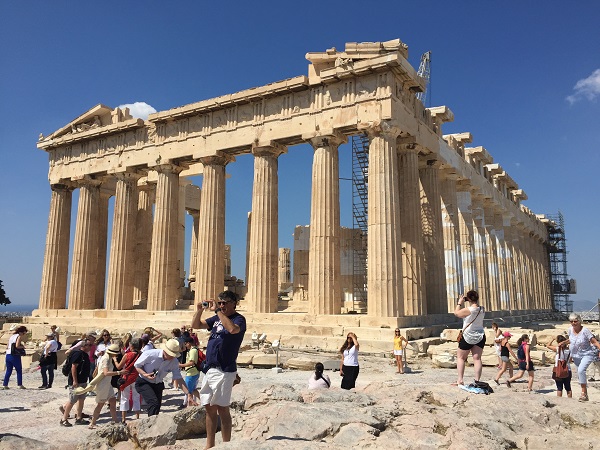
With the launch of the twice-weekly Aegean Airways flight from Luxembourg to Athens, I was lucky enough to be able to travel on the official inaugural flight last Thursday.
With their 174-seater Airbus A320-200 aircraft serving the route, the three-hour journey was punctuated by the cabin staff serving drinks regularly plus, rather surprisingly, a small hot meal.
After flying over the Alps and then down the Adriatic Sea, while coming in to land we could see from the topography of the hilly terrain that between the undulating hillsides - some of which have been quarried - had a mix of tilled arable rectangular fields. Just off the irregular coastline were shallow turquoise waters off white sandy beaches, with linear and distinct roads winding around the hillsides and through towns. As the plane got lower, the buildings started to come into focus and the multi-storeyed flat-rooved apartments mixed with tiled single- and two-storey houses, all followed by a mix of scrubland and olive groves.
Stepping out of the plane, onto the ground with was the home of the ancient Greek civilisation for 4,000 years, but which was destroyed by Herulians in 267 AD. But before we could see the sights, we needed to get into the city. The Athens Metro has just three lines, but its introduction a few years ago immediately resulted in a drop of around one third of the total number of vehicles in the city as the new public transport system was embraced to enthusiastically. With €10 for a one-way ticket (€18 for a return) we needed just one change and we were within a couple of hundred metres of where were were staying.
Up early the following morning we decided to climb the 2,500 year-old Acropolis before the sun got too high and the heat became too much. Unlike Rome where the main archaelogical remains are in the city centre on more-or-less the same level, Athens is very different, with the Parthenon and other must-see ruins located at the top of the rocky outcrop. A €20 entry charge (or €30 which also includes access to other attractions) is well worth being able to walk around the Acropolis (one side of which was under wraps while it is being restored), as well as the Old Temple of Athena and the Erechtheum.
If those are not enough to satisfy one's thirst for architectural and cultural heritage, there is the truly magnificent outdoors Theatre of Dionysus viewed from above where the opera Aida is to be performed early next month - one great reason to return to Athens... But while we were up at the summit we got our bearings and worked out how to get to various other sights on our list that day.
Interestingly, there were no hawkers at all present around the Acropolis - they were limited to the shopping and market areas we later discovered. Also, the refugee crisis that has hit Greece was almost non-evident, with the local authorities keeping them away from the tourist areas.
Walking through the gardens with plenty of flora, we then discovered and explored other sights including the Agora and the Temple of Hephaestus as well as the Museum of Ancient Agora, before exiting to Thissio.
Hungry and thirsty from our morning exertions, we chose one of the many local eating places and sampled some of the traditional dishes - the souvlaki (grilled pork on skewers) and gyros, both large helpings and served with tzatziki sauce and pita bread.
Walking around the pedestrianised shopping streets of Plaka we stumbled into a fish spa, where customers pay to dip their feet in water whereupon Garra Rufa fish (a small member of the carp family) eat away at dead skin and leads its rejuvenated. The shops and stalls were offering everything from replica Greek pottery to Greek sandals and everything else inbetween.
We then made our way towards Hadrian's Arch (constructed in AD 131 as part of the wall separating the old and new parts of the city at that time) and the Temple of Zeus with its imposing 17 metre-high Corinthian columns - just 15 of the original 104 still survive.
The (new, opened in 2009) Acropolis Museum is a spacious four-storey building built over ancient ruins which can be viewed through glass floors. With a €5 entry fee, the museum has much ancient pottery, statues, busts and wall carvings on display, with explanations in both Greek and English.
While we took advantage of just one full day exploring the ancient monuments, etc., there is so much more to do and see - not just other parts of Athens but also other Greek
cities and numerous Greek islands.
Full schedule and network information can be found online at www.aegeanair.com. The airline flies the route on Thursdays and Saturdays until 29 September 2016.
Photos by Geoff Thompson. For full photo album (on Facebook), see https://www.facebook.com/media/set/?set=a.885856524858987.1073741909.238112732966706&type=3









